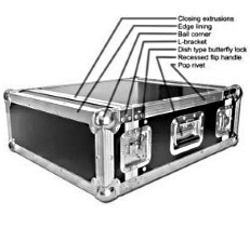The road case is essential to anyone on tour with gear that needs to be protected, so I thought this would be a good time to bring back something that I posted about few years ago.
It’s an excerpt from The Touring Musician’s Handbook that provides a good look at the differences between popular road case styles. Here we go.
For many musicians, buying road cases for their gear is sort of a right of passage. As soon as you stencil your name on the cases, it suddenly means that your stock as a musician has risen and you’ve made the jump to becoming your own brand.
While some players choose not to case up their gear in order to save money in the beginning of their touring career, they soon see the shortsightedness the first time a favorite instrument is damaged from a fall off of a ramp or loading dock. Road cases are not only worth it, but almost mandatory in that your gear always has to work, and the only way to assure that happens is to keep it protected from the frequent and many knocks of the road.
The ATA Standard
Although many cases may look similar, the sturdiest (and consequently most expensive) ones are what’s known as ATA cases. This is a design based on an airplane parts packaging specification (known as ATA 300 Category 1), developed by airline packaging engineers and certified by the Airline Transport Association.
ATA 300 compliant cases are designed to withstand the rigors of being shipped a minimum of 100 times, and specifies that the case will have recessed handles that will not break during transit. The standard also details the level of quality of every piece of construction material that goes into the case, including locks, hinges, and fastening systems, and also states that all rivets and screws must be non-corrosive and all edges must be rounded and have certain level of construction quality. Because of this ATA standard, the typical road case has also come to be known by the name “flight case,” since it’s made principally to survive multiple flights.
Tip: If the road case is too heavy for a single person to carry it, it needs casters.
Types Of Road Cases
Road cases come in a lot of different styles and a lot of different materials. As a result, all road cases are not created equal. Some are great for keeping the weather off your gear, while others are built to withstand the constant battle of the road. Let’s take a look at the different types.
Fiber Cases – Fiber cases are the typical drum cases that most drummers have used some time during their life. They’re made out of fiberglass reinforced polyester and are very strong and rugged. While they work great for the club musician or weekend warrior because they keep the scuffs and incidental scratches off of the instrument, they’re deficient for road work in several ways; there’s little or no shock mounting for the instrument, the case is closed with a nylon strap that can be cut or lost, and their irregular shape make them difficult to pack efficiently.
This means they usually get tossed on the top of the evenly packed square cases in the truck where they bounce around a lot as a result. Guess what that does for the instrument? They’re also prone to caving should something very heavy be placed upon them.
Aluminum – Aluminum cases have a major advantage in being extremely light weight, and usually have a fair amount of shock absorption inside. That being said, they’re very easy to pierce, and should generally not be used for shipping purposes as a result. It’s possible to have an ATA standard aluminum case, but you have to use so much aluminum that you lose the weight advantage that aluminum has over other types of cases.
Carpet Cases – These are simple plywood cases with an outer fuzzy carpet material. This type of construction once again offers little in the way of impact relief and protection. They’re heavy because the internal frame may be constructed of steel, and even though the carpet finish makes them very tough, there’s not much in the way of shock mounting. Carpet cases are great for things like cables and mic stands, but not for anything expensive that must be protected.
















